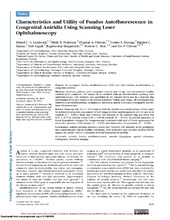| dc.contributor.author | Landsend, Erlend Christoffer Sommer | en_US |
| dc.contributor.author | Pedersen, Hilde Røgeberg | en_US |
| dc.contributor.author | Utheim, Øygunn Aass | en_US |
| dc.contributor.author | Rueegg, Corina Silvia | en_US |
| dc.contributor.author | Baraas, Rigmor C. | en_US |
| dc.contributor.author | Lagali, Neil | en_US |
| dc.contributor.author | Bragadottir, Ragnheidur | en_US |
| dc.contributor.author | Moe, Morten Carsten | en_US |
| dc.contributor.author | Utheim, Tor Paaske | en_US |
| dc.date.accessioned | 2020-08-17T12:50:46Z | |
| dc.date.available | 2020-08-17T12:50:46Z | |
| dc.date.issued | 2019 | |
| dc.Published | Landsend ECS, Pedersen HR, Utheim ØA, Rueegg CS, Baraas R. C., Lagali N, Bragadottir R, Moe MC, Utheim TP. Characteristics and Utility of Fundus Autofluorescence in Congenital Aniridia Using Scanning Laser Ophthalmoscopy. Investigative Ophthalmology and Visual Science. 2019;60(13):4120-4128 | eng |
| dc.identifier.issn | 0146-0404 | |
| dc.identifier.issn | 1552-5783 | |
| dc.identifier.uri | https://hdl.handle.net/1956/23824 | |
| dc.description.abstract | Purpose: To investigate fundus autofluorescence (FAF) and other fundus manifestations in congenital aniridia. Methods: Fourteen patients with congenital aniridia and 14 age- and sex-matched healthy controls were examined. FAF images were obtained with an ultra-widefield scanning laser ophthalmoscope. FAF intensity was quantified in the macular fovea and in a macular ring surrounding fovea and related to an internal reference within each image. All aniridia patients underwent an ophthalmologic examination, including optical coherence tomography and slit-lamp biomicroscopy. Results: Mean age was 28.4 ± 15.0 years in both the aniridia and control groups. Fovea could be defined by subjective assessment of FAF images in three aniridia patients (21.4%) and in all controls (P = 0.001). Mean ratio between FAF intensity in the macular ring and fovea was 1.01 ± 0.15 in aniridia versus 1.18 ± 0.09 in controls (P = 0.034). In aniridia, presence of foveal hypoplasia evaluated by biomicroscopy correlated with lack of foveal appearance by subjective analyses of FAF images (P = 0.031) and observation of nystagmus (P = 0.009). Conclusions: Aniridia patients present a lower ratio between FAF intensity in the peripheral and central macula than do healthy individuals. Both subjective and objective analyses of FAF images are useful tools in evaluation of foveal hypoplasia in aniridia. | en_US |
| dc.language.iso | eng | eng |
| dc.publisher | Association for Research in Vision and Ophthalmology | eng |
| dc.rights | Attribution-Non Commercial-No Derivatives CC BY-NC-ND | eng |
| dc.rights.uri | http://creativecommons.org/licenses/by-nc-nd/4.0/ | eng |
| dc.title | Characteristics and Utility of Fundus Autofluorescence in Congenital Aniridia Using Scanning Laser Ophthalmoscopy | en_US |
| dc.type | Peer reviewed | |
| dc.type | Journal article | |
| dc.date.updated | 2020-01-10T12:46:31Z | |
| dc.description.version | publishedVersion | en_US |
| dc.rights.holder | Copyright 2019 The Authors | |
| dc.identifier.doi | https://doi.org/10.1167/iovs.19-26994 | |
| dc.identifier.cristin | 1741591 | |
| dc.source.journal | Investigative Ophthalmology and Visual Science | |
| dc.relation.project | EC/FP7: 609020 | |

